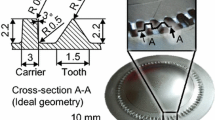Abstract
The aim of this paper is to optimize the analytical model developed in previous work (Hu et al. in Determination of the friction coefficient in deep drawing, process scaling. In: Vollertsen F, Hollmann F (eds) Proceeding of the 1st colloquium of DFG priority program process scaling. BIAS-Verlag, ISBN 3-933762-14-6, Bremen, pp 27–34, 2003; Hu and Vollertsen in J Technol Plast 29:1–9, 2004; Vollertsen and Hu in Annu CIRP 55(1):291–294, 2006) with respect to the distribution of the contact pressure at the drawing radius. A size-dependent friction function was acquired based on the experimentally measured punch force from strip drawing with deflection, which can identify the tribological size effects in sheet metal forming. This function was implemented in the FEM-simulation. The distribution of the contact pressure at the drawing radius was assumed to be uniform in the previous analytical model, which is not right, since the simulated punch force versus punch travel curve showed a difference of about 11% from the experimental curve (Vollertsen and Hu in Annu CIRP 55(1):291–294, 2006). In the new analytical model the non-uniform distribution of contact pressure between the work piece and the tools was taken into account. The simulated curve using the friction function from the new model shows a better agreement with the experimental curve.










Similar content being viewed by others
References
Hu Z, Schulze Niehoff H, Vollertsen F (2003) Determination of the friction coefficient in deep drawing, process scaling. In: Vollertsen F, Hollmann F (eds) Proceeding of the 1st colloquium of DFG priority program process scaling. BIAS-Verlag, ISBN 3-933762-14-6, Bremen, pp 27–34
Hu Z, Vollertsen F (2004) A new friction test method. J Technol Plast 29:1–9
Vollertsen F, Hu Z (2006) Tribological size effects in sheet metal forming measured by a strip drawing test. Annu CIRP 55(1):291–294
Olssen DD, Bay N (2004) Prediction of limits of lubrication in strip reduction testing. Ann CIRP 53(1):231–234
Becker P, Jeon HJ, Chang CC, Bramley AN (2003) A geometric approach to modelling friction in metal forming. Ann CIRP 52(1):209–212
Vollertsen F, Hu Z, Schulze H, Niehoff C (2004) Theiler: state of the art in micro forming and investigations into micro deep drawing. J Mater Process Technol 151:70–79
Engel U (2006) Tribology in microforming. Wear 260(3):265–273
Geiger M, Messner A, Engel U (1997) Production of microparts—size effects in bulk metal forming, similarity theory. Prod Eng 4(1):55–58
Hoffmann H, Hong S (2006) Tensile test of very thin sheet metal and determination of flow stress considering the scaling effect. Ann CIRP 55(1):263–266
Lange K (1990) Umformtechnik—Handbuch für Industrie und Wissenschaft, Band 3: Blechbearbeitung. Springer, Berlin
Storoschew MW, Popow EA (1968) Grundlagen der Umformtechnik. Verlag Technik, Berlin
Kluge S, Wolf H (1991) Berechnen des Biegekraftanteils beim Umformen von Blechen, Bänder Bleche Rohre 11:46–54
Sass F, Bouché CH, Leitner A (1974) DUBBEL, Taschenbuch für den Maschinenbau, Erster Band. Springer, Berlin
Acknowledgments
The work reported in this paper is funded by the Deutsche Forschungsgemeinschaft (DFG) within the project “Modelling of tribological size-effects in deep drawing” (DFG project no. Vo 530/6). The authors would like thank the DFG for their beneficial support. Moreover the authors would like thank the institute of Metal Forming and Casting (UTG) in Munich in Germany for carry out the tensile test for the Al99.5 in thicknesses of 0.02, 0.1, and 0.2 mm.
Author information
Authors and Affiliations
Corresponding author
Rights and permissions
About this article
Cite this article
Vollertsen, F., Hu, Z. Determination of size-dependent friction functions in sheet metal forming with respect to the distribution of the contact pressure. Prod. Eng. Res. Devel. 2, 345–350 (2008). https://doi.org/10.1007/s11740-008-0130-4
Received:
Accepted:
Published:
Issue Date:
DOI: https://doi.org/10.1007/s11740-008-0130-4




